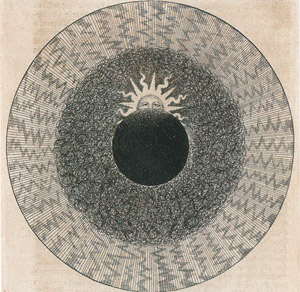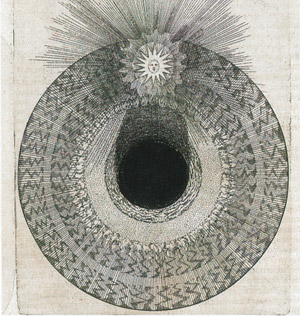
 before the theory of the big bang, before the heliocentric model, indeed before science proper, all manner of theory as to the origins of the cosmos jostled for position. as late as the 17th century religious sects, alchemists, and mystics still held enough sway to throw their own theoretical hats into the ring and receive due consideration. religious sects and mystics are still at it i suppose (intelligent design anyone?) but the alchemists are long gone. what follows is the story of creation as put forth in the book utriusque cosmi historia published in 1617, written by one dr. robert fludd.
before the theory of the big bang, before the heliocentric model, indeed before science proper, all manner of theory as to the origins of the cosmos jostled for position. as late as the 17th century religious sects, alchemists, and mystics still held enough sway to throw their own theoretical hats into the ring and receive due consideration. religious sects and mystics are still at it i suppose (intelligent design anyone?) but the alchemists are long gone. what follows is the story of creation as put forth in the book utriusque cosmi historia published in 1617, written by one dr. robert fludd.

when the secret of secrets wished to reveal himself, he began to produce a point of light. before that point of light broke through and became apparent, the infinite was entirely hidden and radiated no light.

light, the inexhaustible source of all things, appears in the darkness and with it the watery spirits begin to divide into near and far.

in the centre are the dark waters, far from light, forming the source of matter; at the edge are the upper waters, from which the divine fiery heaven will unfold. the bright cloud in between is called the earth spirit.

the chaos of the elements from the lower waters is a confused and undigested mass in which four elements fight against each other.

the ideal final state of material is acheived when the elements are arranged according to the degrees of their density: (from outside in) earth, water, air, fire. in the centre appears the sun, gold.

the firts day of creation. let there be light, said god; and forthwith light sprung from the deep; and from her native east to journey through the aery gloom began.

the uncreated light of the spirit reflected in the sphere of the fiery fermament as in a mirror, and the reflections in their turn, are the first manifestations of created light.

the earth belongs to the lowest level of the elements, the sediment of creation.

according to the proportions, the grossest element couples with the most subtle when the elements of air and water are produced.

the second day: the ethereal sphere with the fixed stars and planets divides the upper waters from the lower. in this sphere the upper heavenly quality (form) is in balance with the lower heavenly quality (material).

the third day: fire, the meterial fire of paracelsus or “dark fire,” arises as the first and most subtle element.

the sequence by which the elements are ordered in an ascending degree of purity- earth, water, air, fire- isrepeated in the structure of the entire cosmos.

the stars on the outer edge of the ethereal sphere anly became visible with the creation of the sun, for they store its light and after a space of time emit it again like phosphorous.

the perturbations attendant on creation had caused some of the celestial light to be trapped in the cold mass of the central earth. obeying the law of gravity, this celestial substance began to rise toward its rightful place in th eheavens, and it was thus that our sun formed.

in the firmamnet the sun is the visible representative of the divine fire and of love. its corresponding part in the human body is the heart, which emits its vital rays in a circle from the centre, and thus animates each individual limb.

when the sinking, hot rays of the sun encounter rising, watery steam, they condense and give rise to planets.

the spirit of god hovers as a dove perfect above creation, which is already menaced by the fall.
———————————————————————-
some notes on the book and its author:
Utriusque cosmi historia - ‘An account of the Macrocosm and the Microcosm’. is a vast tome, issued in five parts during the period 1617-1621, which attempts an encyclopaedic outline and synthesis of the western esoteric ideas on the relationship between the Macrocosm and the Microcosm, the Cosmos and Man. in it author dr. robert fludd attacked aristotle and other ancients (being pagans and thus without possible merit), and attempted to replace them with an understanding of nature based on christian principles, using as his guide the mosaic books of the Bible. He interpreted the Creation account in Genesis as a divine alchemical process, and looked for truth in the Hermetic and Neoplatonic works of late antiquity and the Renaissance, which he interpreted as mirroring Christian truths.
fludd was a prominent english Rosicrucian and Paracelsian physicist, a Kentish Anglican alchemist, an astrologer, prolific author, mystical philosopher, an alleged Grand Master of the Prieure de Sion, and designer of perpetual motion machines. he’s thought by some (thomas de quincey for one) to be “the father of Freemasonry” and… oh yes he was a practicing physician. yikes! quite a resume. if your immediate reaction is to break the glass and sound the kook alarm you wouldn’t be alone.
some pertinent info:
He Latinized his name from Robert Fludd into Robertus a Fluctibus (hahahaha), and began the promulgation of many strange doctrines. He avowed his belief in the philosopher’s stone, the water of life, and the universal alkahest; and maintained that there were but two principles of all things,—which were, condensation, the boreal or northern virtue; and rarefaction, the southern or austral virtue. A number of demons, he said, ruled over the human frame, whom he arranged in their places in a rhomboid. Every disease had its peculiar demon who produced it, which demon could only be combated by the aid of the demon whose place was directly opposite to his in the rhomboidal figure. Of his medical notions we shall have further occasion to speak in another part of this book, when we consider him in his character as one of the first founders of the magnetic delusion, and its offshoot, animal magnetism, which has created so much sensation in our own day.
on the other hand even kooks are not technically barred from waiting at the train platform of truth and were then, as now, forces to be reckoned with.
more pertinent info:
Fludd’s claims about physical reality run an amazing gamut from crazy to insightful. Lightning, for example, was simply not to be understood in physical terms. It was the naked will of God. That’s why it struck the people who didn’t run and hide when they saw it.
But he also believed the sun—not the earth—was at the center of the universe. He said that our blood carries the lifegiving parts of air through our body in a circular motion. That was very close to the modern theory of blood circulation. he is also thought by some to be the original inventor or the barometer.
in fact it’s well known that he was considered important enough to warrant violent refutations from Keppler. and not only keppler. Every 17th-century scientist we know about today took time out to attack Fludd’s ideas. so his most important contribution to science might be the way in which provoked reaction. he served as a lightning rod which finally called the “new science” of the day to strike down on alchemy. it is said that when he died in 1637, alchemy died with him.
for more alchemical and mystical kookery check out memoirs of extraordinary popular delusions (or read the newspaper).







